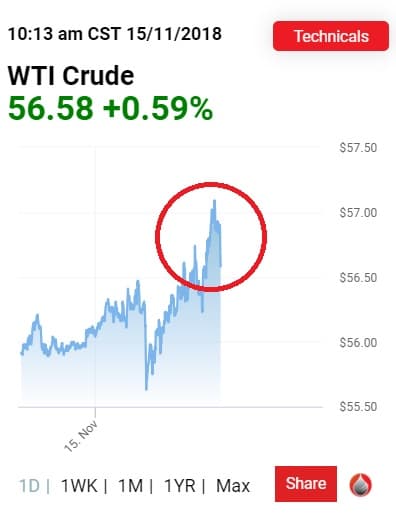The Energy Information Administration reported a huge crude oil inventory build for the week to November 9 of 10.3 million barrels, arresting an improvement in oil prices that started yesterday after a sharp drop earlier this week.
Amid growing concern about a weakening in global oil demand and rising production from OPEC and outside it, notably in the United States, the EIA also reported a 1.4-million-barrel decline in gasoline inventories and another one, of 3.6 million barrels, in distillate fuel inventories.
At 10.1 million barrels daily, gasoline production last week was considerably higher than the 9.7 million bpd booked a week earlier. Distillate fuel production averaged 5 million bpd, virtually unchanged on a week earlier.
Refineries processed 16.4 million barrels daily last week, the EIA said, another flat figure on a weekly basis.
Winter is coming and demand for crude and fuels would normally weaken, pressuring prices. In this sense, the EIA latest weekly report reflects/stands out from normal seasonal demand patterns. Yet its effect on prices is likely to be excessive amid heightened volatility resulting from two new reports with a pessimistic outlook for global demand, from the International Energy Agency and OPEC.
Both IEA and OPEC expect slower demand growth than they did earlier this year, mostly on the back of slower global economic growth. Yet there is also worry about oversupply, resulting once again from the relentless increase in U.S. crude oil production, which two weeks ago hit 11.6 million barrels daily and will likely continued higher last week as well, as drillers added more rigs.
At the time of writing Brent crude traded at US$67.02 a barrel, up modestly from yesterday’s close, after earlier this week plunging close to US$65 a barrel under the double blow of rising supplies and a call from President Trump to OPEC to refrain from production cuts. West Texas Intermediate traded at US$56.86 a barrel, also recouping some of the losses it suffered earlier this week.
WTI slipped almost directly after markets digested the biggest crude build in 21 months

By Irina Slav for Oilprice.com
More Top Reads From Oilprice.com:
- Is OPEC’s Oil Outlook Too Bullish?
- Russia’s Most Powerful Oilman: We're Fine With Any Oil Price
- Bakken Prices Crumble On Pipeline Woes



















Another factor weighing on prices is that the global oil market has not re-balanced completely and that there is a small pocket of glut capable of taking care of outages in Venezuela and elsewhere. That is why Saudi Arabia’s and Russia’s decision to add 650,000 b/d six weeks ago to keep prices down was a major mistake.
Because of its very strategic importance to the global economy, oil is always subjected to various economic and geopolitical pressures virtually on daily basis thus creating a volatility of prices. That is why one shouldn’t be surprised to see oil prices shuttling between bull and bear markets all the time.
A few weeks ago oil hit $87 a barrel. Today it is $67. The day after the markets could change from bearish to bullish sending prices up to $80.
You and other contributors to the oilprice.com continue to extol the impact of US oil production and inventories on the global oil market and prices. If that is the case, then why does President Trump keep haranguing OPEC to raise production to keep prices down. It points to one thing: EIA’s claims are plain untruths.
The robust fundamentals of the global oil market are still the same as they were in October when the oil price hit $87. These fundamentals could still support an oil price ranging from $80-$85 before the end.
Dr Mamdouh G Salameh
International Oil Economist
Visiting Professor of Energy Economics at ESCP Europe Business School, London